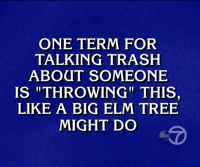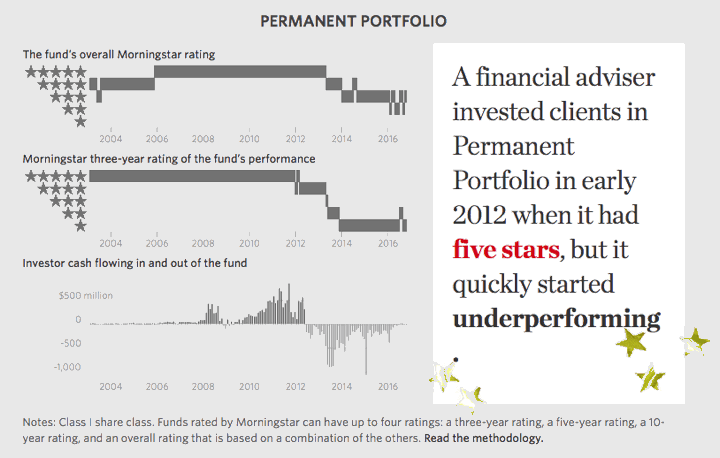 For investment nerds, the recent Wall Street Journal article The Morningstar Mirage was high drama. The subtitle got straight to the point:
For investment nerds, the recent Wall Street Journal article The Morningstar Mirage was high drama. The subtitle got straight to the point:
Investors everywhere think a 5-star rating from Morningstar means a mutual fund will be a top performer—it doesn’t.
Morningstar ratings mainly reflect past performance. However, something called “mean reversion” usually happens. If a fund has done well recently, it will have a high rating. But it usually doesn’t stick. The WSJ has a good visual:

This quote is spot on: “Morningstar’s star ratings for funds are clearly used in the industry to imply that funds that performed well in the past will do so in the future.” Check out the fund flows into the Permanent Portfolio Fund when they were 5-star. Just a couple years later, chheck out the fund flows out when they drop to 1-star.

Morningstar responded with Setting the Record Straight on Our Fund Ratings, which in my opinion just repeated the top graphic above. People think the left part will hold. Reality is the right part.
The Journal’s analysis found that most five-star funds perform somewhat better than lower-rated ones, yet on the average, five-star funds eventually turn into merely ordinary performers.
More importantly, something was conspicuously missing from this rebuttal…
Expense ratios are a more dependable predictor of performance. Source: Morningstar. Back in 2010, Russell Kinnell of M* had what the NY Times called “an act of radical and admirable transparency” in his article How Expense Ratios and Star Ratings Predict Success. Here’s my 2010 post about it.
If there’s anything in the whole world of mutual funds that you can take to the bank, it’s that expense ratios help you make a better decision. In every single time period and data point tested, low-cost funds beat high-cost funds. […] Investors should make expense ratios a primary test in fund selection. They are still the most dependable predictor of performance.
Smart investors know about this article. Morningstar executives choose not to mention it. Why would they? They charge fund companies $10,000 a pop to brag about their 5-star ratings in ads.
This is where my pragmatic side kicks in. I like Morningstar overall. I’m glad they exist. You just have to pick what you consume carefully.
- Morningstar creates a lot of high-quality, free stuff for DIY investors. They have great free data, some nice tools, and many helpful articles from knowledgable authors. I link to them regularly. I talk about star ratings never.
- People love star ratings systems. There’s a reason why you see stars on every Amazon product page. Most people don’t want to filter out everything themselves. They want the feeling that some fancy algorithm has hand-picked the best funds for them. They want easy.
- Financial advisors love star ratings systems. If the financial advisor makes a pick and it goes bad, then whose fault is it? Not mine, I followed the rating system and followed the experts! Financial advisors are incentivized to stay close to the pack, as if they stick out in the wrong way, they will get fired. This is known as minimizing career risk.
- This is not a perfect analogy, but Morningstar is kind of like Whole Foods. You could make some great food at decent prices using their raw ingredients and 365 product line. But 1/3rd of the store is prepared foods, and the most popular are stuff like pizza, sushi, mac & cheese, chicken nuggets, and chicken wings. Why do they sell these things? It is what the customer wants, and they are a for-profit corporation.
10 years from now, I predict that the system will be exactly the same. Morningstar wants to keep it, most clients want to keep it, and the financial advisors want to keep it. Morningstar stock plunged when the WSJ story broke, but recently bounced back up. I suspect people came to the same conclusion as I did.
Bottom line. The WSJ article reminds us of an important lesson. Morningstar “5-star ratings” are simply markers of past performance. Reversion to the mean usually happens. Consider long-term past performance as one factor amongst many, but don’t chase 5-star funds. Expense ratios are a better predictor of future returns than M* star ratings. If anything, simply avoid 1-star funds.
 The Best Credit Card Bonus Offers – November 2024
The Best Credit Card Bonus Offers – November 2024 Big List of Free Stocks from Brokerage Apps
Big List of Free Stocks from Brokerage Apps Best Interest Rates on Cash - November 2024
Best Interest Rates on Cash - November 2024 Free Credit Scores x 3 + Free Credit Monitoring
Free Credit Scores x 3 + Free Credit Monitoring Best No Fee 0% APR Balance Transfer Offers
Best No Fee 0% APR Balance Transfer Offers Little-Known Cellular Data Plans That Can Save Big Money
Little-Known Cellular Data Plans That Can Save Big Money How To Haggle Your Cable or Direct TV Bill
How To Haggle Your Cable or Direct TV Bill Big List of Free Consumer Data Reports (Credit, Rent, Work)
Big List of Free Consumer Data Reports (Credit, Rent, Work)
I stopped finding Morningstar ratings useful in the 1990’s. I am surprised they are still even used today.
It used to be much, much worse. They now at least give out star ratings in each asset class. Previously, if large caps had a good run and small caps underperformed, they would give large-cap funds all 5 stars while small caps may have all been 2 stars. Now at least they compare large-cap strategies relative to other large-cap strategies and a fund that’s down, but has outperformed its peers, can still get a good rating.